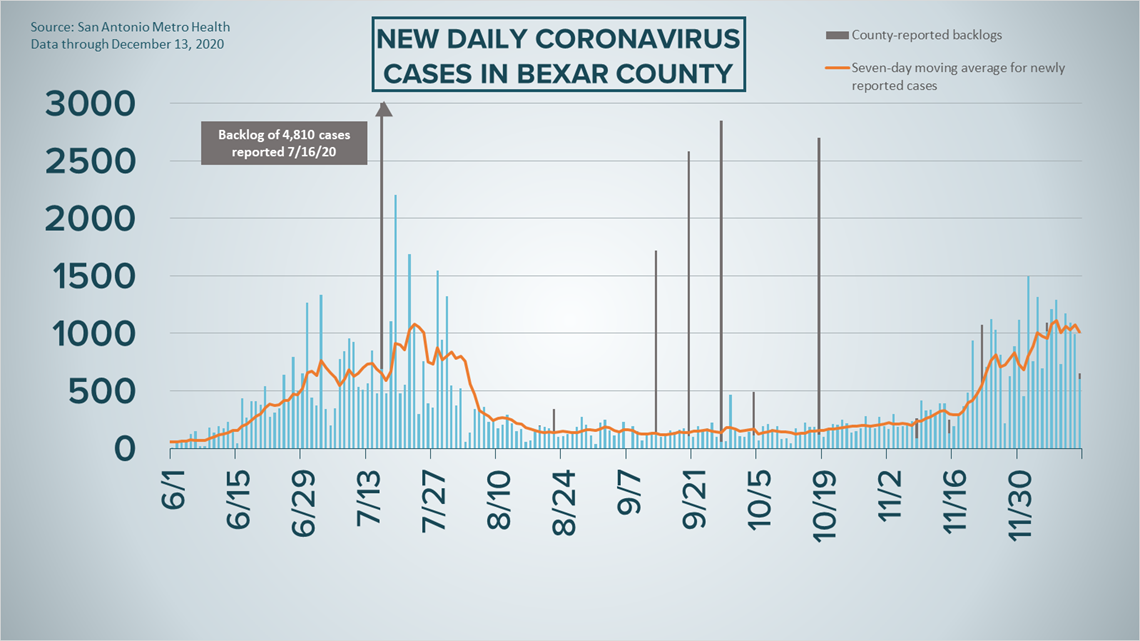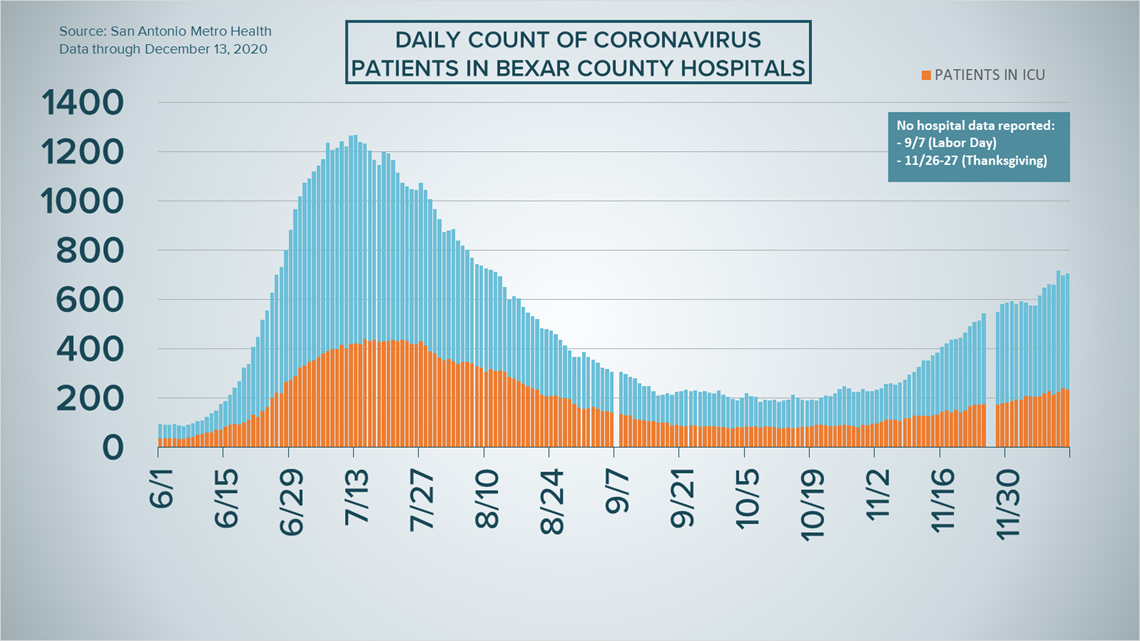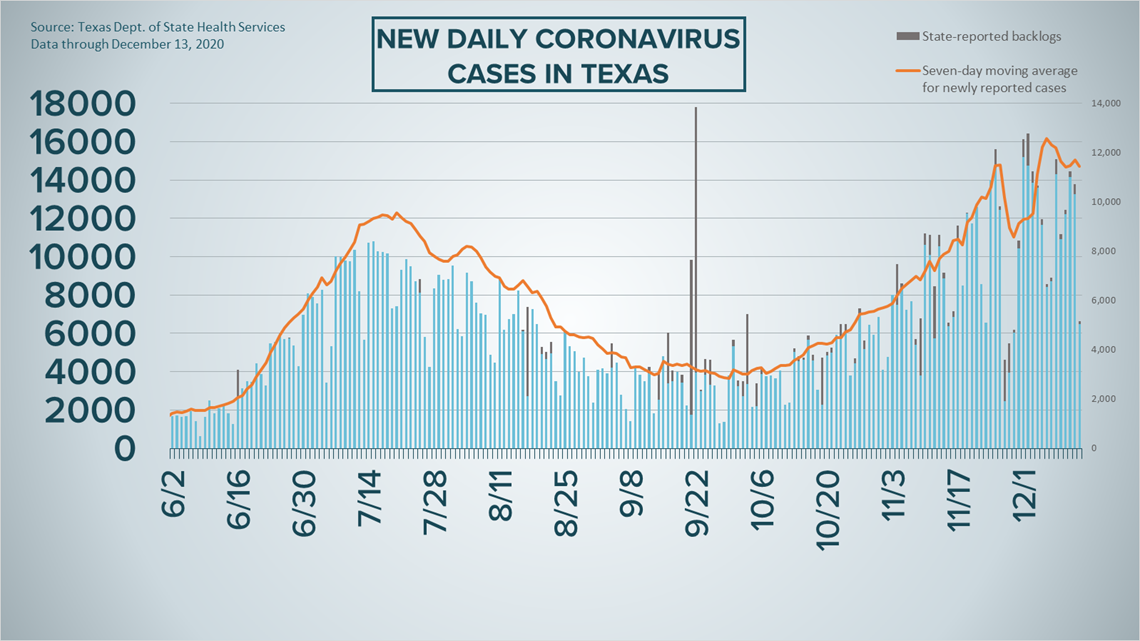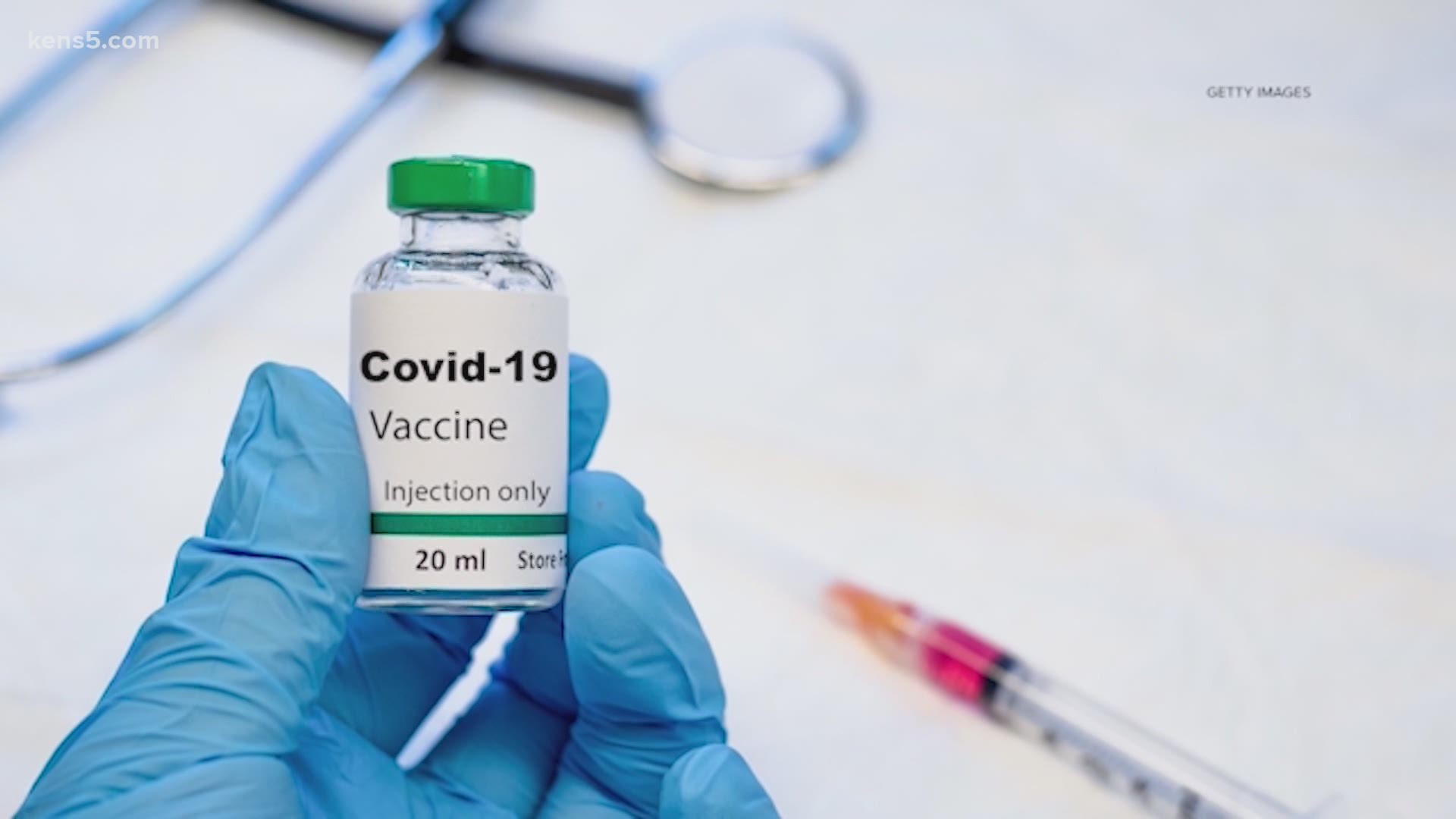SAN ANTONIO — We're tracking the latest numbers from the coronavirus pandemic in San Antonio and across Texas. Here are the latest numbers reported by Bexar and surrounding counties:
- Bexar County: 655 new cases were reported on Sunday along with a backlog of 51, bringing the total number of cases to 94,182. No new deaths were reported, but a backlog of 11 fatalities from November raised the death toll to at least 1,429.
- Hays County: Officials in Hays County on Friday reported 75 new cases in the county and no additional COVID-related fatalities. As of Friday, there are a total of 8,091 lab-confirmed local cases (1,057 of which are active), while the death toll remained at 107. 6,927 residents have recovered from the virus.
- Comal County: Comal County reported an additional 66 coronavirus cases – 15 confirmed, 51 probable – on Friday, bringing its total to 5,272. Officials also tallied one more coronavirus-related fatality, bringing the death toll for the county to 136. The county estimates 725 active cases on Friday, while 4,411 residents have recovered.
More county case information is available through the Texas Department of Health Services COVID-19 dashboard.
How Bexar County is trending
We've tracked how many coronavirus cases have been confirmed in Bexar County from the time officials began reporting cases in March 2020. The graphic below shows the number of cases since June and charts those daily case numbers along a 7-day moving average to provide a more accurate picture of the overall coronavirus case curve in our area and the direction we're trending amid the pandemic.
On Sunday evening, San Antonio Metro Health updated their online dashboard to report an additional 655 coronavirus cases, plus a backlog of 51. A total of 94,182 county residents have been diagnosed in the ongoing pandemic.


No new deaths were reported, but a backlog of 11 fatalities from November raised the death toll to at least 1,429 Bexar County residents.
As of Sunday, 705 patients are receiving treatment for COVID-19 symptoms at area hospitals. Of those patients, 129 are on ventilators and 234 are in intensive care.


Coronavirus in Texas
The total number of novel coronavirus cases in the state since the pandemic began grew by 8,349 on Sunday, according to the Texas Department of State Health Services.
That total includes 6,479 new confirmed cases, 1,671 probable cases, and 199 cases attributed to backlogs not previously reported in the state's total (more details can be found at the top of this page).
As of Sunday, 1.472 million Texans have been diagnosed with COVID-19.


State health authorities also reported 111 additional virus-related deaths on Sunday. At least 23,911 Texans have died from COVID-19 complications.
The number of COVID-19-related hospital patients in the state rose by 38 over the last 24 hours; in all, 9,230 Texans are receiving treatment at hospitals for coronavirus symptoms. That's the highest the number has been since the end of July.
Meanwhile, the state estimates that 1.176 million Texans have recovered, while 272,933 Texans remain ill with COVID-19.
The latest update from the Texas Education Agency showed that there have been 77,826 cumulative cases among staff and students across the state through Dec. 6. That number comprises 48,875 positive student cases and 28,933 staff cases. More information can be found here.
The TEA releases new data on school cases on Fridays.
Latest Coronavirus Headlines
- White House, other top officials to get early access to coronavirus vaccine
- CDC advisory committee votes, approves recommendation for Pfizer COVID-19 vaccine in the US
- Food banks dependent on federal aid to avoid shortages in 2021
- Country music legend Charley Pride dead at 86 of coronavirus complications
- VERIFY: Allergic reactions from COVID-19 vaccines in the UK, and what that means for the US
- Americans paying the price for Thanksgiving as virus spreads
Coronavirus symptoms
The symptoms of coronavirus can be similar to the flu or a bad cold. Symptoms include fever or chills, cough, shortness of breath or difficulty breathing, fatigue, muscle or body aches, headache, new loss of taste or smell sore throat, congestion or runny nose, nausea or vomiting and diarrhea, according to the Centers for Disease Control.
Most healthy people will have mild symptoms. A study of more than 72,000 patients by the Centers for Disease Control in China showed 80 percent of the cases there were mild.
But infections can cause pneumonia, severe acute respiratory syndrome, kidney failure, and even death, according to the World Health Organization. Older people with underlying health conditions are most at risk.
But infections can cause pneumonia, severe acute respiratory syndrome, kidney failure, and even death, according to the World Health Organization. Older people with underlying health conditions are most at risk.
Experts determined there was consistent evidence these conditions increase a person's risk, regardless of age:
- Chronic kidney disease
- COPD (chronic obstructive pulmonary disease)
- Obesity (BMI of 30 or higher)
- Immunocompromised state (weakened immune system) from solid organ transplant
- Serious heart conditions, such as heart failure, coronary artery disease, or cardiomyopathies
- Sickle cell disease
- Type 2 diabetes
The CDC believes symptoms may appear anywhere from two to 14 days after being exposed.
Human coronaviruses are usually spread...
- Between people who are in close contact with one another (within about 6 feet).
- Through respiratory droplets produced when an infected person coughs, sneezes or talks. These droplets can land in the mouths or noses of people who are nearby or possibly be inhaled into the lungs.
- Some recent studies have suggested that COVID-19 may be spread by people who are not showing symptoms.
Help stop the spread of coronavirus
- Stay home when you are sick.
- Eat and sleep separately from your family members
- Use different utensils and dishes
- Cover your cough or sneeze with your arm, not your hand.
- If you use a tissue, throw it in the trash.
Find a Testing Location
City officials recommend getting a COVID-19 test if you experience fever or chills, cough, shortness of breath or difficulty breathing, fatigue, muscle or body aches, headache, new loss of taste or smell, sore throat, congestion or runny nose, nausea or vomiting, or diarrhea.
San Antonio operates several no-cost testing locations, including two walk-up locations open Monday-Sunday from 10 a.m. until 2 p.m.:
Cuellar Community Center
5626 San Fernando St.
San Antonio, TX 78237
Ramirez Community Center
1011 Gillette Blvd.
San Antonio, TX 78224
Additionally, Freeman Coliseum offers drive-through no-cost testing from Monday through Sunday between 9 a.m. and 4 p.m. An appointment is required and can be made either online or by calling (833) 213-0643.
Here's a Testing Sites Locator to help you find the testing location closest to you in San Antonio.

